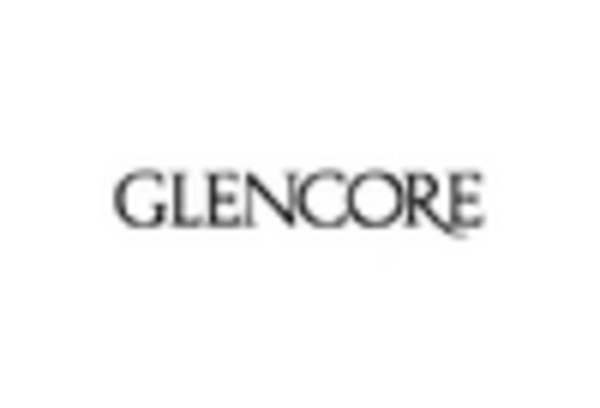Increased Focus on Recycling
The transition metals market is also being influenced by a heightened focus on recycling initiatives. As the U.S. aims to reduce waste and promote circular economy practices, the recycling of transition metals is gaining traction. In 2025, the recycling rate for metals is projected to reach 30%, driven by consumer demand for sustainable products. This trend not only conserves natural resources but also reduces the environmental footprint associated with mining. Consequently, the transition metals market is likely to see a shift in supply dynamics, with recycled metals becoming a more significant component of the overall market.
Rising Demand in Renewable Energy
The transition metals market is experiencing a notable surge in demand driven by the renewable energy sector. As the U.S. government emphasizes clean energy initiatives, the need for transition metals such as nickel and cobalt, which are essential for battery production, is increasing. In 2025, the market for lithium-ion batteries is projected to reach approximately $100 billion, with a significant portion of this growth attributed to electric vehicles (EVs) and energy storage systems. This trend suggests that the transition metals market will continue to expand as more companies invest in sustainable energy solutions, thereby creating a robust demand for these metals.
Infrastructure Development Initiatives
Infrastructure development in the U.S. is a critical driver for the transition metals market. The Biden administration's infrastructure plan, which allocates $1.2 trillion for various projects, is likely to boost the demand for transition metals such as copper and aluminum. These metals are vital for construction, electrical wiring, and transportation systems. As the U.S. aims to modernize its infrastructure, the transition metals market is expected to benefit significantly. In 2025, the demand for copper alone is anticipated to increase by 15%, reflecting the growing need for these materials in large-scale infrastructure projects.
Geopolitical Factors and Trade Policies
Geopolitical factors and trade policies are playing a crucial role in shaping the transition metals market. The U.S. has been actively reassessing its trade relationships, particularly with countries that are major producers of transition metals. Tariffs and trade agreements can significantly impact the availability and pricing of these metals. For instance, any restrictions on imports from key suppliers could lead to a 10% increase in domestic prices. As the U.S. navigates these complexities, the transition metals market may experience fluctuations in supply and demand, influencing overall market stability.
Technological Innovations in Metal Extraction
Technological advancements in metal extraction processes are reshaping the transition metals market. Innovations such as hydrometallurgy and bioleaching are enhancing the efficiency of metal recovery from ores, thereby reducing costs and environmental impact. These methods are becoming increasingly relevant as the U.S. seeks to minimize its reliance on imported metals. The transition metals market is likely to see a shift towards more sustainable extraction techniques, which could lead to a 20% increase in production efficiency by 2027. This evolution in extraction technology may attract new investments and drive growth in the market.

















Leave a Comment